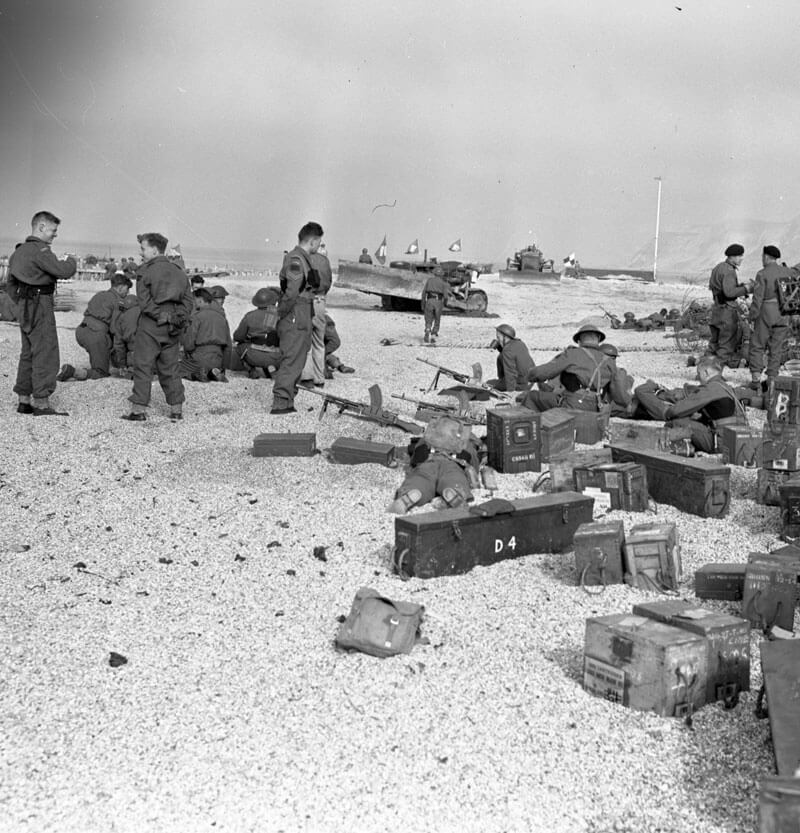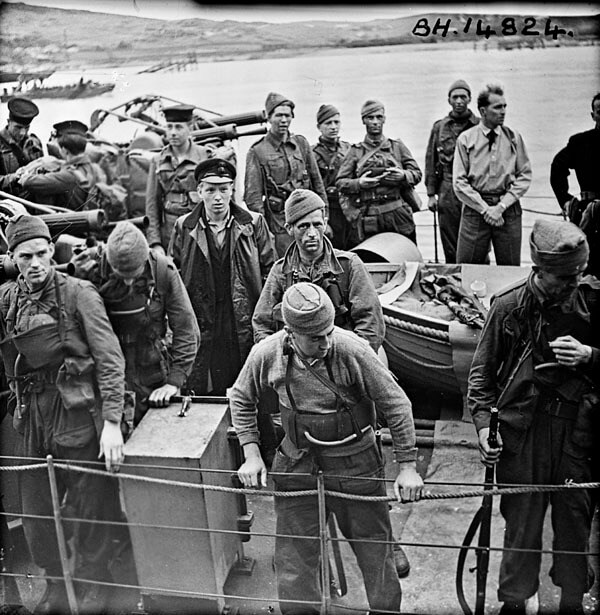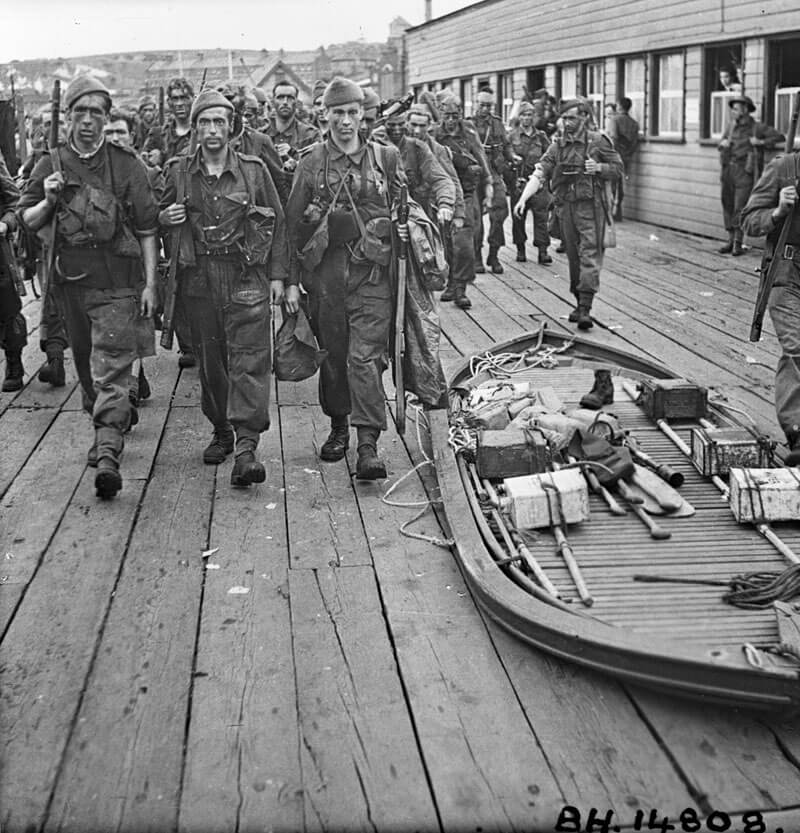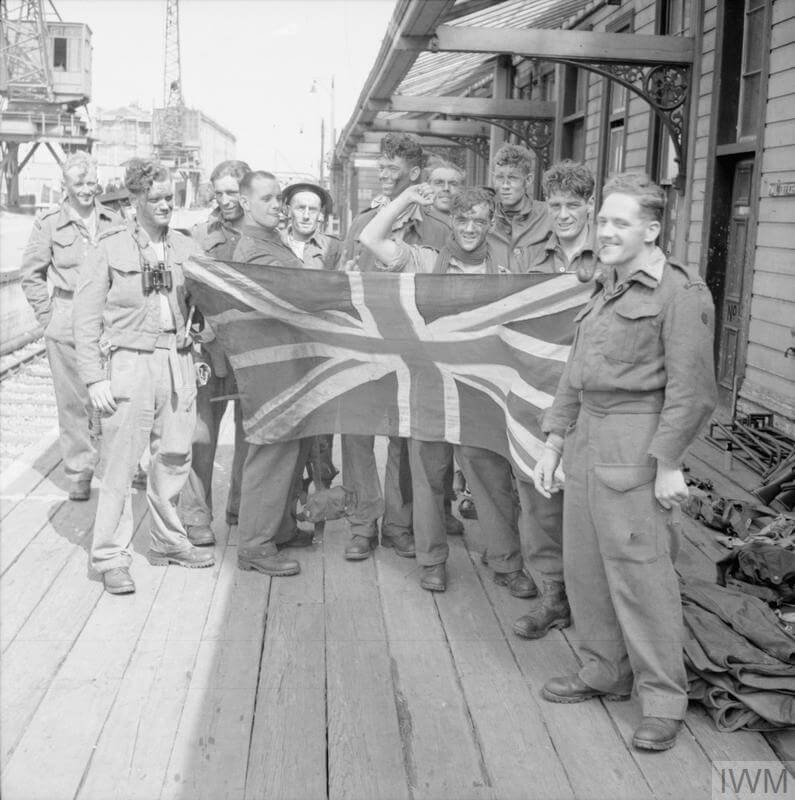| Page Created |
| September 4th, 2022 |
| Last Updated |
| September 8th, 2022 |
| Country |
 |
| Special Forces |
| August 19th, 1942 |
| Operation Jubilee |
| Objectives |
- Probe German defences on the coast of France, and to test the Allies ability to mount an amphibious assault, using combined forces.
- Land with an amphibious assault.
- Take Dieppe.
- Hold a perimeter around the town for some time.
- Destroy the German coastal defences, port structures and important buildings.
- Withdraw by sea.
| Operational Area |
- The port town of Dieppe.
- Beaches at Vasterival and Quiberville, south of Dieppe.
- Beaches at Berneval and Belleville-sur-Mer, north of Dieppe
| Allied Forces |
Army
Canada
- 2nd Canadian Infantry Division
- 4th Canadian Infantry Brigade
- The Essex Scottish Regiment
- The Royal Hamilton Light Infantry
- The Royal Regiment of Canada
- 5th Canadian Infantry Brigade
- Three platoons of The Black Watch (Royal Highland Regiment) of Canada
- Mortar Platoon of The Calgary Highlanders
- 6th Canadian Infantry Brigade
- Les Fusiliers Mont-Royal (Floating reserve)
- The Queen’s Own Cameron Highlanders of Canada
- The South Saskatchewan Regiment
- No. 6 Defence Platoon (Lorne Scots)
- 14th Army Tank Regiment (The Calgary Regiment [Tank])
- Detachment of 3rd Light Anti-Aircraft Regiment, Royal Canadian Artillery
- Detachment of 4th Field Regiment, Royal Canadian Artillery
- The Toronto Scottish Regiment (Machine Gun)
- 4th Canadian Infantry Brigade
Great Britain
- No. 3 Commando
- No. 4 Commando
- No. 10 Inter-Allied Commando (French troop)
- No. 40 Commando, Royal Marines
- No. 30 Commando
United States
A detachment of 50 men from the 1st U.S. Ranger Battalion.
Naval Forces
Great Britain
Eight Hunt-class destroyers:
- H.M.S. Albrighton
- H.M.S. Berkeley, support to H.M.S. Calpe, controlled low fighter cover squadrons also First Rescue Ship
- H.M.S. Bleasdale
- H.M.S. Brocklesby
- H.M.S. Calpe – Headquarters ship
- H.M.S. Fernie – reserve HQ ship
- H.M.S. Garth
- ORP Ślązak (Polish Navy)
- H.M.S. Locust, un boat, Cutting Out Force, carrying RM Commandos
- 9th Minesweeper Flotilla
- 13th Minesweeper Flotilla
- Nine landing Ships, Infantry (LSI) carrying landing craft and troops
- H.M.S. Duke of Wellington, Landing Ship, Infantry (Hand-Hoisting)
- H.M.S. Glengyle – Landing Ship, Infantry (Large)
- H.M.S. Invicta – Landing ship, Infantry (Small)
- H.M.S. Prince Charles, Landing ship, Infantry (Small)
- H.M.S. Prince Leopold, Landing ship, Infantry (Small)
- H.M.S. Princess Beatrix, Landing Ship, Infantry (Medium)
- H.M.S. Princess Astrid, Landing ship, Infantry (Small)
- H.M.S. Prins Albert, Landing ship, Infantry (Small)
- H.M.S. Queen Emma, Landing Ship, Infantry (Medium)
Royal Navy Coastal Forces
- 12 Motor Gun Boats
- 4 Steam Gun Boats of the 1st Steam Gun Boat Flotilla.
- 20 Motor Launches
Airforce
- 11 Group RAF Fighter Command
- Spitfire squadrons
- No. 19 Squadron RAF
- No. 41 Squadron RAF
- No. 43 Squadron RAF
- No. 64 Squadron RAF
- No. 66 Squadron RAF
- No. 81 Squadron RAF
- No. 87 Squadron RAF
- No. 91 Squadron RAF
- No. 111 Squadron RAF
- No. 122 Squadron RAF
- No. 124 Squadron RAF
- No. 129 Squadron RAF
- No. 130 Squadron RAF
- No. 131 Squadron RAF
- No. 134 Squadron RAF
- No. 154 Squadron RAF
- No. 165 Squadron RAF
- No. 222 Squadron RAF
- No. 232 Squadron RAF
- No. 242 Squadron RAF
- No. 501 Squadron RAF
- No. 602 Squadron RAF
- No. 610 Squadron RAF
- No. 611 Squadron RAF
- No. 616 Squadron RAF
- Spitfire squadrons
- Squadrons for ground attack
- No. 3 Squadron RAF
- No. 32 Squadron RAF
- No. 87 Squadron RAF
- No. 174 Squadron RAF
- No. 175 Squadron RAF
- No. 245 Squadron RAF
- No. 253 Squadron RAF
- Three Hawker Typhoon squadrons
- No. 56 Squadron RAF
- No. 266 Squadron RAF
- No. 609 Squadron RAF
- RAF Army Cooperation Command, No. 35 Wing
- No. 239 Squadron RAF
- RAF Army Cooperation Command, No. 36 Wing
- No. 13 Squadron RAF Bristol Blenheim light bomber (laying smoke)
- RAF Army Cooperation Command, No. 32 Wing
- No. 614 Squadron RAF Bristol Blenheim light bomber (laying smoke)
- A squadron with Bristol Beaufighter
- No. 2 Group RAF (RAF Bomber Command)
- No. 88 Squadron RAF Boston III, (tactical bombing)
- No. 107 Squadron RAF Boston III, (tactical bombing)
- No. 226 Squadron RAF Boston III, RAF (laying smoke)
The RAF Air Sea Rescue Service also operated some aircraft.
United States
- USAAF Eighth Air Force
- 97th Bombardment Group
- 340th Bombardment Squadron
- 341st Bombardment Squadron
- 342nd Bombardment Squadron
- 414th Bombardment Squadron
- 31st Fighter Group (Spitfires)
- 307th Fighter Squadron
- 308th Fighter Squadron
- 309th Fighter Squadron
- 97th Bombardment Group
- 11 Group RAF Fighter Command
- Spitfire squadrons
- No. 71 (Eagle) Squadron RAF
- No. 121 (Eagle) Squadron RAF
- No. 133 (Eagle) Squadron
- Spitfire squadrons
Poland
- 11 Group RAF Fighter Command
- Spitfire squadrons
- No. 302 “City of Poznań” Fighter Squadron
- No. 303 “Kościuszko” Fighter Squadron
- No. 306 “City of Toruń” Fighter Squadron
- No. 308 “City of Kraków” Fighter Squadron
- No. 317 “City of Wilno” Fighter Squadron
- Spitfire squadrons
Czechoslovakia
- 11 Group RAF Fighter Command
- Spitfire squadrons
- No. 310 Squadron
- No. 312 Squadron
- Spitfire squadrons
Norway
- 11 Group RAF Fighter Command
- Spitfire squadrons
- No. 331 Squadron
- No. 332 Squadron
- Spitfire squadrons
France
- 11 Group RAF Fighter Command
- Spitfire squadrons
- No. 340 (GC/IV/2 Ile de France) Squadron
- Spitfire squadrons
Belgium
- 11 Group RAF Fighter Command
- Spitfire squadrons
- No. 350 Squadron
- Squadrons for ground attack
- No. 43 Squadron RAF
- Spitfire squadrons
Canada
- 11 Group RAF Fighter Command
- Spitfire squadrons
- No. 401 Squadron RCAF
- No. 403 Squadron RCAF
- No. 411 Squadron RCAF
- No. 412 Squadron RCAF
- No. 416 Squadron RCAF
- Spitfire squadrons
- RAF Army Cooperation Command, No. 35 Wing
- No. 400 Squadron RCAF
- No. 414 Squadron RCAF
- No 418 (City of Edmonton) Squadron RCA
South Africa
- RAF Army Cooperation Command, No. 35 Wing
- No. 26 Squadron RAF
| Axis Forces |
Heer
- 302nd Static Infantry Division
- 570th Infantry Regiment
- 571st Infantry Regiment
- 572nd Infantry Regiment
- 302nd Artillery Regiment
- 302nd Reconnaissance Battalion
- 302nd Antitank Battalion
- 302nd Engineer Battalion
- 216th Battery
- 813th Battery
- 2/770 Army Coastal Battery
- Heavy Flak Group
Reserves
- 676th Infantry Regiment of the 332nd Static Infantry Division
- 10th Panzer Division
- SS Infantry Brigade Leibstandarte Adolf Hitler
Luftwaffe
- Jagdgeschwader 2
- Jagdgeschwader 26
- Kampfgeschwader 2
- II./Kampfgeschader 40
- 1.(F)/123 Reconnaissance
| Operation |
April 4th, 1942
Admiral Mountbatten, Commander Combined Operations, asks his staff to draw up proposals for a large raid against Dieppe. The objects of the operation are to
carry out a reconnaissance in depth and to challenge German occupation troops to relieve pressure on the Eastern Front.
April 18th, 1942
Chiefs of Staff Committee agrees to a ‘reconnaissance in force’ against Dieppe, codenamed ‘Rutter’, to take place in early July.
April 30th, 1942
Canadian 2nd Infantry Division is chosen to carry out the attack.
May-June, 1942
Canadian troops move to the Isle of Wight and undergo intensive training for the operation.
July 2nd, 1942
In the face of worsening weather, troops are embarked on board the assault convoys In the Solent ready to carry out Operation Rutter.
July 7th, 1942
The convoy of ships carrying the forces destined for Dieppe is bombed at anchor in the Solent by German aircraft. The operation is abandoned due to continuing bad weather and the assault forces are disbanded.
July 22nd, 1942.
The Dieppe operation is reinstated. Combined Operations makes some changes to the plan, including substituting Commandos for airborne forces to capture the large German coastal batteries. The operation is given the new codename Operation Jubilee.
August 18th, 1942
Embarkation of the forces taking part in Jubilee begins in five ports along the south coast. The force has been dispersed for security and safety reasons. During the evening, the attack force sails for Dieppe from Southampton, Portsmouth, Gosport, Shoreham and Newhaven.
August 19th, 1942
01:55 The seaborne force passes safely through the German minefields in the Channel.
03:20 All troop-carrying ships have reached their lowering positions, and all have loaded and launched their assault landing craft. The groups who have crossed the Channel in Eureka boats line up for the run in to the beaches.
03:30 Each group of landing craft heads for their designated invasion beach. They are protected by destroyers on their flanks.
03:47. The group of twenty-four landing craft transporting No. 3 Commando are heading for Berneval on Yellow Beach I and in Belleville-sur-Mer on Yellow Beach II to the east of Dieppe. While moving towards their landing area they run into a German flotilla. German S-boats escorting a German tanker torpedo some of the landing craft and disable the escorting Steam Gun Boat 5. Motor Launch 346 (commanded by Lieutenant A.D. Fear Royal Naval Volunteer Reserve DSC) and Landing Craft Flak 1 combine to drive off the German boats. In the confusion of the attack several landing craft are damaged and forced to turn back, while others are reported missing and believed to be sunk. Since the confrontation also eliminates the much counted on element of surprise, the decision is made to abandon the attack.
This is unknown to seven of the landing craft who are presumed to be missing and sunk. These craft keep heading for Yellow Beach. They arrive much later than planned.
0430. Group One of No. 4 Commando lands in Vasterival at Orange Beach I under command of Major Derek Mills Robert. After landing Group One makes it straight for the gullies in front of their landing position that led off the beach. All haste is called for as the lighthouse had shut down, indicating the raid may have been detected. No. 2 Section clears the houses immediately above the beach and guards the gully down to the beach.
The single section of A Troop attached to Group One works its way behind the lighthouse and cut the observers telephone cable running from it back to the battery. Once C Troop works its way forward to the wood edge facing the battery position, they are engaged in a firefight with the Germans.
The Group One A Troop section then works around the flank of the German positions and engages them from positions among the houses. 0540. All of C Troop is in position and starts pouring rifle, Bren light machine-gun, Boys anti-tank rifle and mortar fire onto the Germans.
Group Two of No. 4 Commando lands on Orange Beach II at Ste Marguerite-sur-Mer, led by Lord Lovat. Their landing is not so easy as that of Group One. A Troop (less the section attached to Group One) comes ashore under fire from mortars and machine-guns and has to deal with the thick barbed wire entanglements, suffering four casualties in the process.
The commandos used Rabbit netting to cross the wire. The remainder of the Group Two, comes ashore one hundred metres up the beach from A Troop, also taking casualties. Relief comes when the mortar fire is lifted to focus on the withdrawing British landing craft.
At the woods to the rear of the German Battery B and F Troops split. B Troop continues east and follows the southern edge of the wood. They then split into their sections and use fire and movement to advance through the orchard and village. They silence a machine-gun post in the process and are soon in position to assault the battery. Ninety-five minutes after landing they are ready for the assault.
F Troop heads northeast towards the rear of the battery. Using the cover of smoke, they advance from the wood on the German positions to penetrate their wire perimeter. They surprise a patrol of Germans just inside organising an assault on C Troop from Group One. The F Troop commandos assault, killing all the Germans in the Patrol. When finished, further resistance is met in and around the farm buildings. The fighting is fierce, but the commandos’ special combat training shines through, they prove quick and deadly against all opposition encountered. Several more casualties are sustained. Finally, they reach their planned start positions for the assault on the battery.
The Force HQ moves up between the positions of B and F Troops, coming under fire from F Troop, but this is soon stopped by radio calls from the HQ.
04:50. To the west of Dieppe, in Pourville at Green Beach, landing craft carrying 503 men from the Queen’s own Cameron Highlanders, under command of Lieutenant Colonel Gostling, and 523 men from the South Saskatchewan Regiment, commanded by Lieutenant Colonel Merrit land late and at the wrong spot.
The group of Camerons are to take an easterly course toward the village of Petit Appeville, and link up with the tanks which land in Dieppe.
This group reaches Petit Appeville, but is forced to retreat when faced with the arrival of German reinforcements. The Saskatchewan troops, whose mission is to neutralise the defences surrounding the Four Winds farm, and to take the Freya radar station, run into heavy opposition while crossing over a narrow bridge spanning the Scie River. They take numerous casualties.
The unit comes close to station but only succeeds in cutting off the electrical power supply line for the radar station. Of the 1,026 men who land, 160 are killed, and 256 are taken prisoner. The remaining 610 men make it back to the landing craft and return to England, 269 of them are wounded during this mission.
05:06. The initial wave of the Royal Regiment of Canada lands on the pebble beach, late due to the sea battle hindering their approach. Pebble beach is a tiny beach: only two hundred metres long, well-fortified and boxed in between high cliffs. It is here where the worst tragedy of Operation Jubilee unfolds. It is now daylight and the wreaked surprise effect results in this wave being quickly decimated by enemy fire, forcing the Allied soldiers to shelter beneath a 4-meter-high sea wall.
05:30. After the attack on the German coastal defences by the Royal Air Force, the frontal assault on the Dieppe beach begins.
On the east end of Dieppe, named Red Beach, the Essex Scottish Regiment lands while the Royal Hamilton regiment lands on the Western section, named White Beach. Both regiments land under heavy fire by the Germans.
The Royal Hamiltons are tasked with taking the Casino. A severe battle ensues around this building. A few light units try to reach the city center but run into such heavy resistance that they are forced to retreat. Most of the soldiers are trapped on the beach beneath the seawall
05:35. The first wave of the Calgary Regiment (Tank), equipped with Churchill tanks which are used for the very first time, disembark fifteen minutes late under heavy shelling. Of the twenty-nine tanks which land on the White and Red beaches, only seven manage to cross over the parapet along the beach. The rest is destroyed by the heavy shelling or damaged by the rocky surface of the beach which destroys the treads of the tanks. While advancing along the esplanade, the tanks empty their ammunition against the enemy defences.
After seeing what happened to the first wave of tanks, the second wave is not allowed to disembark
During the air assault by German airplanes on the Allied ships, the H.M.S. Berkeley is bombed and began to sink. Luckily, her sister ship H.M.S. Albrighton was nearby and picked up her crew.
05:40. Only 124 Commandos of No. 3 Commando land on Yellow Beach I and II in seven landing craft. They are assigned with attacking the Goebbels Battery, landing on the eastern flank. The battery is located near Berneval-le-Grand, about five hundred metres from the sea with steep cliffs in front of it. The plan is that No. 3 Commando is going to land on two beaches, Yellow beach I and II to the east and west of the battery right from where the gullies rise towards the battery. This will provide concealment while the Commandos approach the battery.
Six landing craft land on Yellow Beach I and only one landing craft arrives on Yellow Beach II. The 120 men that land at Yellow I, run into heavy German opposition. Thirty-seven of them are killed, while eighty-one are captured, mostly after having been wounded, and just one manages to evade capture and return to Britain. Among those that are killed is Lieutenant Edward Loustalot, a US Army Ranger, who was the first American soldier to be killed in the European theatre of operations. The smaller party, under Major Peter Young, however, has more luck and manages to advance within 180 metres of the battery. Due to the lack of numbers, they were unable to launch an assault on the battery. Instead, they proceed to harass the gunners for several hours. They are able to distract them from their purpose of firing on the anchorage before they are forced to withdraw. They succeed, briefly, to divert the guns from their task of firing on the ships off the coast.
In the meantime, gunship H.M.S. Locust charges between the jetties. Its mission is to take out the German barges tied up in the rear port. After which the Free French submarine reconnaissance ships would have to take and capture the barges, manning them with Marine Commandos. However, the Bismarck battery fires on them with such intensity that the H.M.S. Locust is forced to turn back, and abort the mission.
05:55. Six landing craft carrying a company of the Black Watch Highlanders bring in the second wave of men on Pebble Beach. This wave undergoes the same punishment Royal Regiment of Canada.
In just a few minutes over two hundred Allied soldiers lose their lives while another 289 become Prisoners of War. Of the 554 men who set foot on the beach, only sixty-five returned to Great Britain.
06:00. Both Group One and Two of No. 4 Commando are in position for the assault and firing on the battery. A Troop (the section attached to Group One) continues to inflict heavy casualties on the Germans from their flank position west of the battery.
The planned Hawker Hurricane flight arrives on time to strafe the battery position, unfortunately they are followed by some FW-190 Focke-Wulf fighters who interrupt their strafing run.
B Troop attacks the buildings to the east of the guns while F Troop storms the battery position itself. F Troop rushes across the open ground through defensive fire overrunning several strong points to finally end amongst the battery itself. All the Germans are quickly dispatched, with only four prisoners taken for intelligence purposes. The guns are made inoperable by explosive charges. Gun barrels, breach blocks and other equipment vital for the batteries continued use are destroyed.
06:20 No. 3 Commando is ordered to withdraw from battle and retreat.
06:30 After completing their mission No.4 Commando withdraws. B, C and F troops withdraw to Group One’s landing beach while A Troop guards the St. Marguerite flank in case of German counterattack. A German patrol is sent from St. Marguerite and ambushed by A Troop. Once the wounded are withdrawn, A, B, C and F troops retire covered by C Troop who is the last off the beach. The whole operation had been a complete success. No. 4 Commando has suffered forty-five casualties, twelve killed, twenty wounded and thirteen missing.
07:00. Onboard the H.M.S. Calpe, one of the eight destroyers carrying the command infrastructure of the operation, the operational commanders receive messages giving conflicting information.
General Roberts, commander of the entire Operation Jubilee, assumes that the Essex Scottish team has crossed the beach esplanade and decides to send out the Fusiliers Mont Royal, held in reserve, onto Red Beach. They land with their twenty-six landing craft, too far to the west and find themselves trapped on the pebble beach, suffering heavy casualties
07:05. The 155mm guns of Heavy Battery Hess are sabotaged, by the No. 4 Commandos. The unit suffers minimal loses and re-embarks for Newhaven, Great Britain with two prisoners, after having incapacitated more than a hundred Germans.
09:00. With no advancement being achieved; General Roberts informs headquarters in England that re-embarkation is going to take place at 10:30. He asks for sufficient air cover to protect their retreat.
Unfortunately, the Royal Air Force does not have any aircraft available in that sector, so the retreat is pushed back to 11:00. The extra half hour seemed an eternity to the soldiers trapped on the beach.
11:00. Chaos reigns over the landing beaches when the troops scattered all along the beach try to re-embark on the landing craft. Their retreat is conducted under heavy German artillery fire. The shells hitting the water and a heavy screen of black smoke complicates the retreat even more.
In the sky above Dieppe, a small air battle is fought out, against a larger German force than at the start of the raid, and under extensive anti-aircraft fire.
During the assault, the Canadians lose 907 killed, 2,460 wounded and 1,946 captured soldiers. The british lose 275 commandos, while the attached US Army Rangers lose. three killed, five wounded and three captured men. With it losing their first men in the European Theatre. The Royal Navy loses one destroyer, thirty-three landing craft and 550 killed and wounded men. The Royal Air Force, loses 64 Supermarine Spitfire fighters, 20 Hawker Hurricane fighters, 6 Douglas Boston bombers, and 10 North American Mustang Mk 1 fighters, suffering
Sixty-two killed thirty wounded seventeen captured airmen.
| Multimedia |
| Training |


| Attack |

| Aftermath |










Lord Lovat, Capt Gordon Webb
nd Capt Boucher-Myers consult
with each other after the raid.








